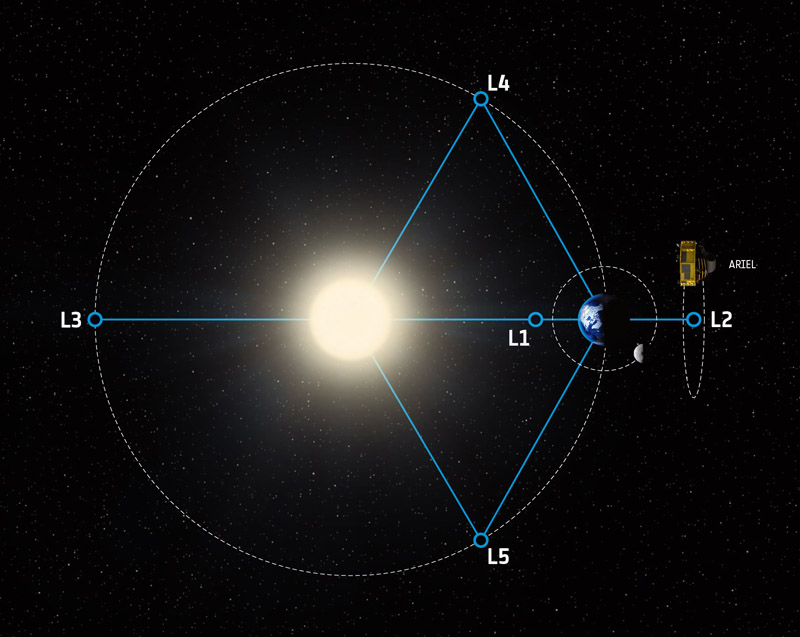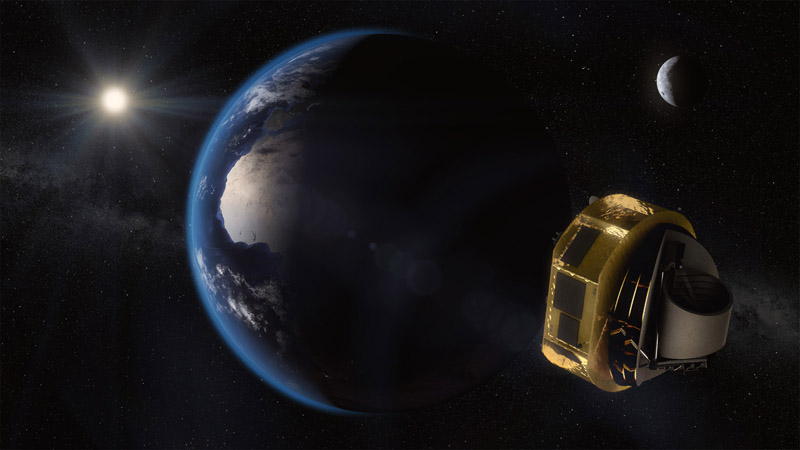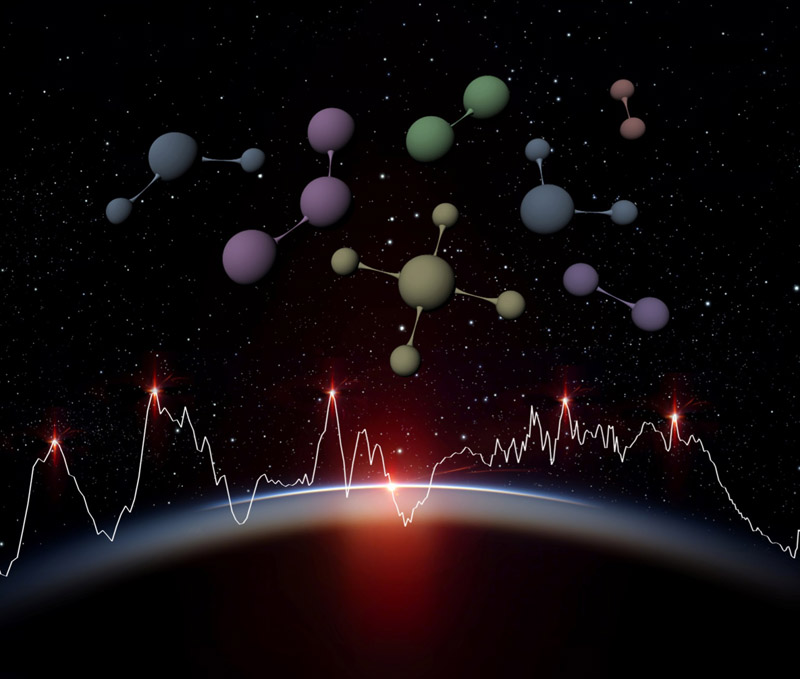THE ARIEL SPACE MISSION SELECTED BY THE EUROPEAN SPACE AGENCY
The ARIEL satellite for observing exoplanets has just been selected by the European Space Agency (ESA) for launch in 2028. A researcher, an engineer and a collaborating post-doctoral fellow at the IAP are involved in the design and development of construction of the ARIEL spectrometer, entrusted to French teams. ARIEL will decipher the properties of the atmospheres of exoplanets.
The program committee of the European Space Agency has just selected the ARIEL mission (for “Atmospheric Remote-Sensing Infrared Exoplanet Large-survey”) as the 4th intermediate-class mission (budget 450 million euros) of the "Cosmic Vision" program. ARIEL will be launched from the Kourou base in French Guiana and will be placed in orbit at the Lagrange L2 point (Figure 1), located 1.5 million kilometers from the Earth (Figure 2).
ARIEL is a space telescope that will systematically probe the atmospheres of 1000 extrasolar planets, from gaseous giants to rocky planets, whether hot or temperate, around stars of different types. ARIEL will measure the composition and structure of planetary atmospheres, constrain the nature of planetary cores, detect the presence of clouds, and investigate interactions with the host star.
The ARIEL mission was proposed by a consortium of more than 60 institutes in 15 European countries. Scientific and technical coordination is provided by the United Kingdom (under the responsibility of Giovanna Tinetti, Professor at University College London, and former post-doctoral fellow at IAP). The two main partners are France and Italy, accompanied by Poland, Spain, the Netherlands, Belgium, Austria, Denmark, Ireland, Sweden, Hungary, the Czech Republic, Germany, Portugal. A contribution from the United States is currently being studied.
The selection process by ESA took place in several stages:
- call for proposals for missions announced by ESA in August 2014;
- pre-selection in June 2015 of 3 missions (THOR, XIPE and ARIEL) out of the 27 proposed, for detailed concept studies;
- evaluation of the results of the studies of the 3 competing projects by an ESA expert committee in the fall of 2017, and recommendation of ARIEL to be the 4th ESA middle class mission, after SOLAR-ORBITER, Euclid and PLATO;
- formal vote of the ESA Programs Committee on March 20th, 2018 and public announcement on March 21st with a launch scheduled for spring 2028.
ARIEL will consist of a telescope about one meter in diameter to collect the visible and infrared light of stars around which orbits an exoplanet. A spectrometer will spread this light in wavelength, producing a spectrum (Figure 3). When the exoplanet passes in front of its star, absorption bands caused by the molecules present in the atmosphere of the exoplanet will be superimposed on the spectrum of the star and will allow the researchers to analyze the atmosphere of the exoplanet.
In 2007, water vapor, then carbon dioxide and carbon monoxide were detected in the atmosphere of hot Jupiter HD189733b thanks to Spitzer satellites, then Hubble. Studies began in 2008 with the objective of having dedicated and optimized instruments for the study of planetary atmospheres. Drawing on the accumulated expertise, the French teams under the direction of Jean-Philippe Beaulieu (IAP), took a very important part in the ARIEL studies from 2015, and contributed decisively to the development of the scientific proposal. This led the French teams to take responsibility for the design and manufacture of the infrared spectrometer at the heart of the satellite, to carry out simulations of the observed spectra (Camilla Danielski, Observatoire de Paris and IAP) and the scenarios of the mission (studies conducted by Andrea Moneti, IAP, and CNES staff). The spectrometer will be built under the project management of CNES and CEA (led by Pierre-Olivier Lagage, Department of Astrophysics at CEA-Irfu, AIM Paris-Saclay UMR), the IAS (led by Marc Ollivier), with a contribution (led by Pierre Drossart) from the Laboratoire d'Etudes Spatiales et d'Instrumentation en Astrophysique (Observatoire de Paris). A fifth French laboratory is involved in the construction of this instrument, the Laboratoire d’Astrophysique de Bordeaux.

Figure 1: ARIEL will be in orbit around the L2 Lagrange point, 1.5 million kilometers from the Earth. It is a point of equilibrium with respect to the combined gravitation exerted by the Sun and the Earth, and which is regularly used for astronomical observatories, thus being able to observe in a direction simultaneously opposed to the Sun and to the Earth (Planck, and the future JWST). Note that the scales are not respected in this figure, the distance between the Sun and the Earth being about 150 million kilometers, which is actually 100 times greater than the distance from the point L2 to the Earth (and the Sun is about 100 times bigger than the Earth).
Credit: ESA/STFC RAL Space/UCL/Europlanet-Science Office

Figure 2 : Artist's view of ARIEL (right) on its way to the L2 Lagrange point (with the Sun on the left and the Earth in the center). One can see the thermal shield of the satellite protecting it from the Sun.
Credit: ESA/STFC RAL Space/UCL/Europlanet-Science Office

Figure 3 : The light of the host star of an exoplanet observed by ARIEL is filtered by the atmosphere of the planet which is on the line of sight between the telescope and the star. ARIEL will thus detect the molecules present in the atmospheres of 1000 exoplanets thanks to spectroscopic observations: the light is dispersed in the manner of a rainbow, and makes it possible to measure the luminosity emitted as a function of wavelength; one can then identify lines characteristic of atoms and molecules known on Earth. These observations make it possible to deduce the chemical composition, the temperature and the pressure in the atmosphere of the observed planet.
Credit: ESA/C.Carreau and ATG medialab
Writing and contact
- Jean-Philippe Beaulieu
Institut d’astrophysique de Paris, CNRS, Sorbonne Université
beaulieu [at] iap [dot] fr
Contacts
- Andrea Moneti
Institut d’astrophysique de Paris, CNRS, Sorbonne Université
moneti [at] iap [dot] fr
- Camilla Danielski
Dépt. Galaxies, Etoiles, Physique et Instrumentation (GEPI), Observatoire de Paris et Institut d’astrophysique de Paris, CNRS, Sorbonne Université
Camilla.Danielski [at] obspm [dot] fr
- Pierre-Olivier Lagage
Dépt. d’Astrophysique au CEA-Irfu, UMR AIM Paris-Saclay
Pierre-Olivier.Lagage [at] cea[dot] fr
- Pierre Drossart
Laboratoire d'Études Spatiales et d'Instrumentation en Astrophysique (LESIA), Observatoire de Paris, CNRS, Université PSL, Sorbonne Université, Université Paris-Diderot
Directeur.Lesia [at] obspm [dot] fr
- Marc Ollivier
Institut d’Astrophysique Spatiale (IAS), CNRS / Université Paris-Sud / Université Paris-Saclay
Marc.Ollivier [at] ias [dot] u-psud [dot] fr
Web writing: Valérie de Lapparent
Layout: Jean Mouette
March 2018
